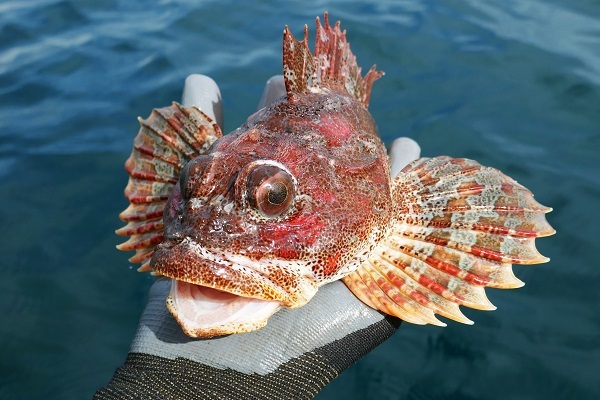The Cleverly Camouflaged Red Irish Lord
Photo credit: Ryan Fields
In honor of St. Patrick’s day this month, we’re celebrating the colorful ‘Irish’ lords that roam off our coast – specifically the ‘Red Irish Lord’ (Hemilepidotus hemilepidotus). Red Irish Lords belong to a group of fish called sculpins, and are members of the ‘Cottidae’ family which include at least 275 species worldwide (1). Their scientific name comes from a combination of Greek words for ‘half’ and ‘scaled’ – referring to the large and distinct scales arranged in two bands along its back.
Seen In Our Hook-and-Line Surveys
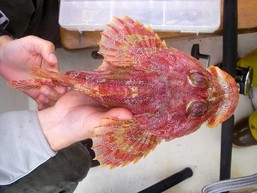
Red Irish Lord are most commonly found between Northern California and Alaska, from the intertidal zone out to water depths of 90m. In our marine reserve hook-and-line surveys over the years we’ve encountered 27 Red Irish Lord. Most of these were observed at our northernmost survey sites, at the Cape Falcon Marine Reserve and associated comparison areas, in water depths between 18-30m (60-100ft). Red Irish Lord have a maximum recorded size of 51cm (20in), but the largest individual the ODFW Marine Reserves Program has sampled was 40cm (15.7in). We routinely encounter three other sculpin species during our surveys: Brown Irish Lord (a close relative to Red Irish Lord), Buffalo Sculpin, and Cabezon. Photo credit: Anne Beaudreau
Interesting Characteristics
|
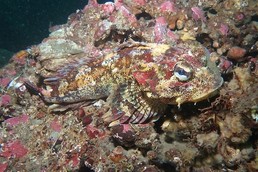
Sculpin species are commonly caught by recreational and commercial fishers, in nearshore and deeper waters, here in Oregon. Red Irish Lord are a ‘demersal species’ meaning that most of their life is spent on the seafloor – primarily in rock and gravel habitats. Their stocky, armored heads, are equipped with sharp spines to help fend off would-be predators. The distinct mottled patterns along their body help them blend into their surroundings as they lie in wait for unsuspecting prey. Their clever camouflage enables it to save energy and wait for their dinner to come to them. Red Irish Lord consume a variety of scrumptious prey ranging from crabs, snails, brittlestars and other small invertebrates, to small fish and octopus (1).
Photo credit: Sara Thiebaud
What's Not To Like?
|
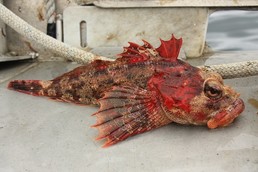
Despite such vibrant colors, not everyone appreciates catching sculpins, and in some places these fish are considered a nuisance and have earned nicknames like ‘bullhead’ and ‘double ugly’. To be fair, the spines can be prickly and there isn’t always much to eat on a sculpin. The ODFW Marine Reserves Program staff happen to think that the bright and variable shades of red, pink, white, and brown help Red Irish Lord stand out as something special in Oregon’s marine reserves and stand worthy of commemoration in this month's newsletter. Photo credit: Ryan Fields
Learn More About Sculpins
Check out this blog post by UW researcher Dr. Anne Beaudreau to learn more about how special Sculpins really are.
Reference:
(1) Love, M. 1996. Probably More Than You Want to Know About the Fishes of the Pacific Coast. Really Big Press, Santa Barbara, California.
|
Upcoming Seminar: Public Perceptions of
Oregon Coastal Resources and Marine Reserves
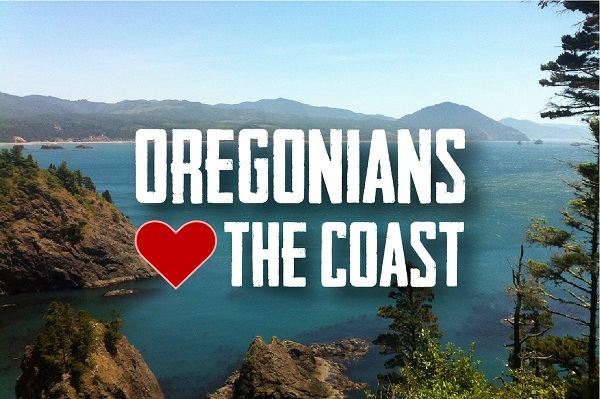
Join Portland State University (PSU) Associate Professor, Dr. Max Nielsen-Pincus, and PSU doctoral student, Kaegan Scully-Engelmeyer, in a virtual seminar on public perceptions of Oregon coastal resources and marine reserves. The seminar will include results from a survey exploring the relationships between awareness, attitudes and beliefs towards coastal and marine resource issues and uses. In addition, the presentation will cover the results of a related public participation geographic information system (PPGIS) mapping survey to identify perceived values of specific coastal spaces and marine areas (study featured in last month's newsletter).
Attend the HMSC Virtual Seminar on Thursday, April 15, 2021
from 3:30 PM to 4:30 PM

Updates on Spring Fieldwork
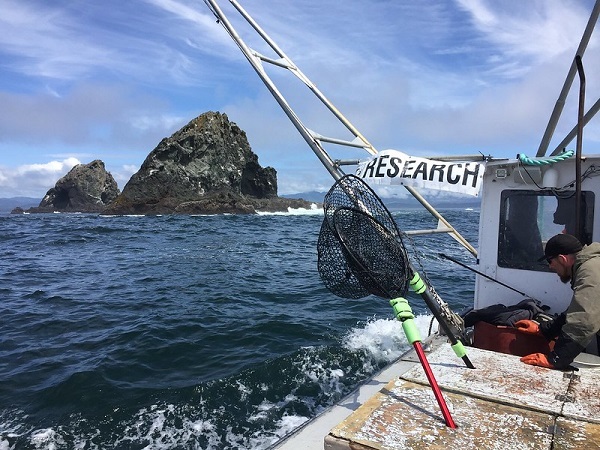 Photo: Research being conducted in 2017 at Orford Reef (comparison area for Redfish Rocks Marine Reserve) aboard the F/V Top Gun
 |
|
Oceanographic Monitoring - With longer days and sunshine returning to the coast, we’ll be embarking on some limited fieldwork this spring that can be done safely during the COVID-19 pandemic. Building on the success of our 2020 fieldwork efforts, we'll be setting out oceanographic moorings with sensors at four marine reserve sites this year – at Redfish Rocks, Cape Perpetua, Cascade Head and Cape Falcon. We plan on getting our oceanographic moorings into the water sometime between April-May for collecting data on temperature, salinity and oxygen. We’ll retrieve the moorings and sensors later this fall, around September. |
 |
|
Data Analysis and Writing - ODFW Marine Reserves Program staff are presently submerged in data analysis and writing. These efforts are to develop the ODFW Marine Reserves Program Synthesis Report, which will report on the program's activities and monitoring over the last 10 years. The Synthesis Report will be completed and released in December. |
Explore More Marine Reserves News

|




